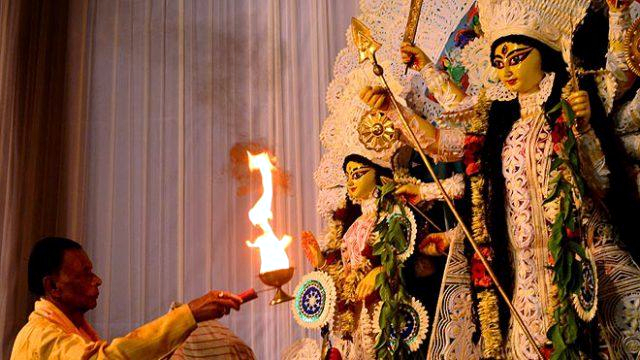
Dussehra, also known as Vijayadashami, is an important Hindu festival celebrated at the conclusion of Navratri celebrations, on the tenth day in the Hindu calendar month of Ashvin, which is on October 25, this year.
The word ‘Dussehra’ is a variant of Dashahara, a compound Sanskrit word composed of ‘dasham’ (ten) and ‘ahar’ (day). ‘Vijayadashami’ is a composite of two words, ‘vijaya’ (victory) and ‘dashami’ (on the tenth), connoting the festival on the tenth day.
The festival, held with great vibrancy and ethnicity, celebrates ultimately the victory of good over evil. It also signifies the establishment of dharma and the abolishing of adharma, hence it marks new beginnings, freedom from all negativity and evil and taboos present inside a person in the form of biases, stereotypes and prejudices and the establishment of new and fresh ideas in society.
In most of northern and western India, since it is celebrated in honour of Lord Ram’s victory over the demon king Ravan, across the country, the Ramlila is enacted wherein the life of Lord Ram and his adventures are acted out in the form of plays.
Each of these plays end with the characters of Ram and Lakshman shooting flaming arrows at giant effigies of Ravan, his brother Kumbhakaran and son Meghanad, which are stuffed with fireworks and flammable materials.
In many regions of Southern India, since the festival is dedicated to Saraswati, the Hindu goddess of knowledge, learning and arts, people maintain, clean and worship their instruments and tools of their livelihood and worship goddess Saraswati.
In west India, both God Rama and Goddess Durga are revered for their victory over evil. People worship the idol of Durga with utmost devotion. They perform puja and pray to the Goddess for peace and prosperity in their families.
CELEBRATIONS IN GOA
Goa has a special relation with Durga and hence, with Dussehra festival. There is a story which says that after the victory of Goddess Durga over the demon Mahishasura in a severe battle, the Goddess became very peaceful and calm and took up residence in Gomanchal (Goa) in the famous Shantadurga temple in Ponda.
The festival is celebrated as the marriage of Lord Shiva with the Goddess Shakti, hence Parvati, who is Shiva’s consort, is worshipped in the various forms of Goddess Durga such as Mauli, Sateri, Shantadurga, Bhumika. So, wherever these temples are located in Goa, the festivities also take those forms and include decorative ‘tarangas’ (umbrellas).
Small and huge effigies of demon king Ravana are burnt on the previous night. Homes are cleaned and decorated with flowers and small earthen lamps in the evening. Temples are decorated with several diyas (light lamps) and other colourful lights, flowers and rangoli art. The grand event begins with religious rituals early in the morning and at dusk, a procession of the deity seated in a palki (palanquin) is carried out. Clay statue of the Goddess Durga is immersed in the water.
The Dhangars, a tribe that lives in harmony with nature on the hills surrounding Goa, have a three-day celebration on Dussehra. They worship an embodiment of life in Goddess Malchi Pandhar and other clan deities through the observance of their age-old rites and rituals and with folk dance performance. The celebrations are also an occasion to show their gratitude to various elements of nature, an integral part of their lives.
In Pernem, Dussehra celebrations, known as Kojagiri Poornima, are associated with the festival of Pednechi Punav. During the night, the Kotkar clan, the Guravas (local priests), the Kumbhars (potters), the Sutars (carpenters) and the Mahar clans perform the Tarangmel dance (a very energetic dance, of very elaborate dance steps while holding that decorative umbrella). At night, they pacify Lord Bhutnath with the assurance that they will build a temple in his honour.
In Poinguinim-Canacona, Dussehra is celebrated differently. During Dussehra/Navratri festival, the ‘Tarang’, the ‘Satri’ (a representation of Navdurga) and a big
bunch of vibrant peacock feathers called the ‘Nirakaracho Pillkucho’ (a representation of the Nirakar (the formless) are carried in processions up to the Navdurga temple. People welcome it with oil lamps and throw fragrant flowers in its path throughout the night till the procession reaches the Shri Navdurga temple.
At night, they perform the traditional ‘Gondhol” dance (‘gondhol’ literally means chaos), a very elaborate and energetic dance performed to the heart throbbing beats of the Dhol and the Taasha.
In recent times, besides the native traditions, the culture of other regions of the country have taken a foothold in Goa as well, be it the Durga Pooja tradition as it is celebrated in Bengal or the ‘Garbha’ and ‘Dandia Raas’ of Gujarat. These festivities have been assimilated completely in the way Goa celebrates Dussehra.
(The writer is former director of Thomas Stephens Konknni Kendr at Porvorim)